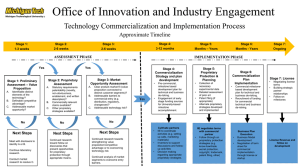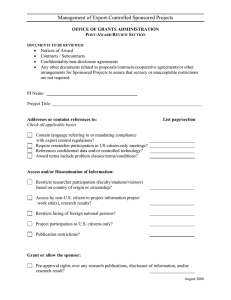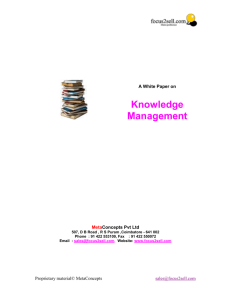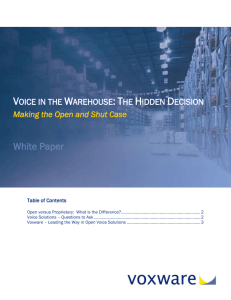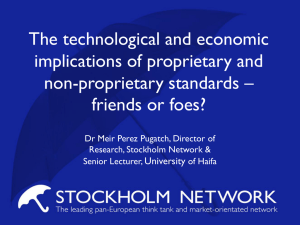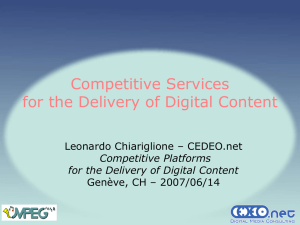ITU and EBU Presentation A perspective on trends and content delivery environment
advertisement
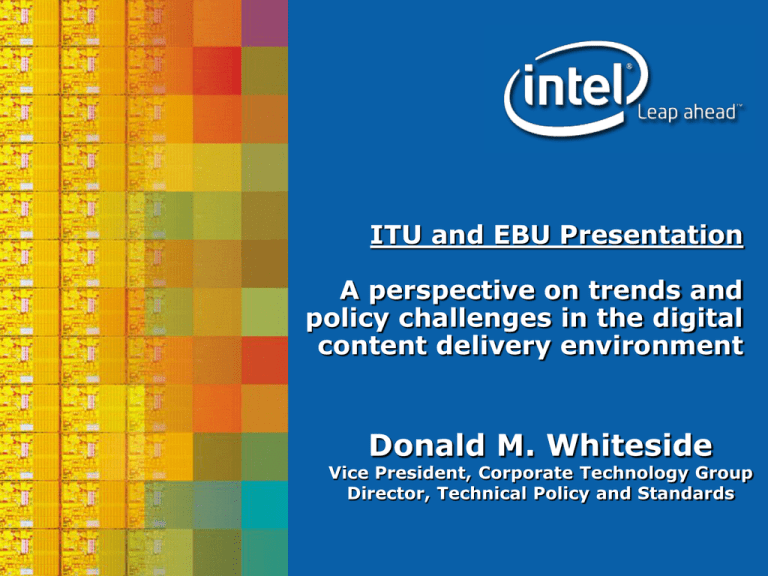
ITU and EBU Presentation A perspective on trends and policy challenges in the digital content delivery environment Donald M. Whiteside Vice President, Corporate Technology Group Director, Technical Policy and Standards Intel’s Policy Perspective Copy LEFT Content should be FREE Content should not be protected Balancing public/private Interests Content should be reasonably PROTECTED Our Content Policy – a Balancing act Respect for Intellectual Property, Rights Holders and Consumers A Reasonably Protected Digital Environment is Necessary Infrastructure For Digital Future Protected Digital Environment Should Provide Consumers Flexibility, Portability and Choice Markets, Not Mandates, Stimulate Innovation and Deliver Consumer Value Content is Copy Property RIGHT Basic Content Protection Security Tools •Technology is Basic Tool Content distributed in encrypted form. Technology and “keys” are licensing “hook”. •License Agreements create Root of Trust and govern Products Decryption keys subject to license; license sets out rules for products/manufacturers. •Copyright Laws (DMCA, EUCD) target Pirates Neither License Nor Technology works against Pirates. Effectiveness of Specific Tools Laws Licensing Technology Casual copier Hobbyist Hacker Small scale pirate Professional pirate Vision: . . . voice, video- and data-streams can be exchanged seamlessly on all-digital networks, competition between delivery platforms will intensify . Broadcast (protected by CA) Internet Content (protected by DRM) Portable Playback (protected by Portable DRM) Optical Copies (protected by AACS, CPRM, CSS) (Web) Internet Personal content Streaming Content (protected by DTCP-IP) Optical (protected by DRM) Vision assumes consumer choice, flexibility and portability based on interoperability Interoperability Challenge: Competing Interests and Business Models Content Providers IT : Generally, Service Providers •Proprietary Model A Service Providers •Proprietary Model B Service Providers •Proprietary Model C Service Providers •Proprietary Model D Standardizing technology will not standardize business models CE: Mixed interests, many business models Consumers: want choice, Service Providers •Proprietary Model E Service Providers •Proprietary Model X wants access to all services with one/all devices Governments, Regulators and Courts Can laws compel interoperability? flexibility and portability: access to all services with one/all devices Multiple Services on Common Platforms Maximize Consumer Choice and Leverage Volume Manufacturing Personal & premium content Internet ecosystem Open environment Premium content Service provider ecosystem Closed environment Standards Based Security* Service Security Open Platform (e.g. STB) PC Service Computing Platform Some Key Policy Challenges Service: How to bring proprietary verticals to common platforms? Standard Security: Consumer is “not” trusted from service perspective; Need for common robustness and compliance? Service/Content Protection: Protection, Consumer policing Privacy and Consumer Notice: Device control, personal information, Security Challenges: Security Goals: Keep “Honest People Honest” • • • “Reasonable Protection” Perfect systems not possible/necessary (CSS) Commercial Viability is Key Technology Challenge: Cost-Effective End to End Systems • • • • • Many security standards assume user is trusted Low Cost Technology Licenses Hardware and/or Software, PC and/or CE Implementation OK Reasonable System Resources Reasonable Implementation Costs Trends: – Increasing security requirements creating a bidding war – Bidding wars lead to proprietary HW and gate maximum choice Privacy and Consumer Notice “Protecting Content” “Policing Consumer” • Content is encrypted • Consumer gets clear content • Consumer buys and “opts in” • No consumer “opt in”, BUT • Devices maintain protection of the specific content. • Device looks for an invisible mark and won’t play content anyway • Examples: • Examples: •DVD Content •DVRA/Holling: Screen CGMSD •MSDRM Sourced Content •SCD: “Spy-ware” limits coping •Cable/Satellite Content •DVD: Audio Watermark? •AACS Content •AACS: Audio Watermark Use Technology to Enable a Protected and Productive Digital Market. Use Technology to Police Consumer in Home and Internet. What Notice is adequate? Consumer Notice and Privacy “Tracking” • • • • Content marked at distribution Mark identifies the distributor Mark is invisible to consumers Escaped Content traced back to distributor • Examples: •“United” mark on airline content Use technology to track escaped content back to licensed distributors “Policing” • Invisible mark inserted into content in consumer device • Mark is invisible to consumer • Mark identifies consumers • Escaped Content forensically traced to consumer • Examples: •CableSTB adds consumer ID •Purchased audio file contains purchaser’s email address Use Technology to Police Consumer in Home and Internet. What notice is good enough? Levies, Private Copies and Market Dynamics • Markets function best when consumers with full information pay directly at the point of sale for all rights associated with specific goods and services. • Levies undermine market principles and emphasize importance of information and notice. -What rights do I get, express and implied? -What is my total cost, direct and indirect? -What technical limitations • What is the role of government? Private parties?
